The city of El Cid is a town of mysteries. Burgos hides secrets between the walls of its cathedral and under the tiles of its streets. Starting with the city name, which does not come from the term ‘burgo’, like the rest of the Jacobean populations. Its origin is in the pluralization of ‘burg’, from the Greek pyrgos, which means tower or fortification.
Five mysteries of Burgos
Burgos is a city of pilgrims, and throughout the Middle Ages, merchants and those who made the Camino de Santiago, left their mark on the history of the town. In its streets, we can see the facades of what were the houses of the nobles, which previously shared the street with hospitals and shelters. The history of the city is marked by the magic and enigma of the Middle Ages, and for that reason, today we bring you five mysteries of Burgos to better understand everything that these streets hide.
The erased face of the cathedral

He upper cloister of the cathedral de Burgos is a space that was used for various functions: from burials to being a place where liturgical celebrations were held. In it, there is a human figure, which visitors do not usually notice. It’s about a bust with erased face. This figure has intrigued José Antonio Gárate, a graduate in Humanities, who has worked in the cathedral since 2003.
The bust could be a clergyman or a monk, as he wears a dark garb, and is also the only figure painted black in the cathedral. At first glance, it seems that the stone deteriorated over time, but after investigating, Gárate discovered that it was deliberately erased to avoid superstitions. Tool marks appear on the face, which is the only damaged part of the figure, a sign that someone intentionally scraped the figure. In addition, the humanist discovered in a 1600 record that the council had the face of a figure removed at the entrance of the cloister to avoid superstitions. Would this be the figure you were referring to?
Flycatcher

He Flycatcher It is one of the major tourist attractions of Burgos Cathedral. It is a figure that open and close your mouth when the clock strikes the hours, but that also houses a romantic legend. The Flycatcher was a work commissioned by the king Henry III ‘The Sorrowful’, who went every day to pray in the cathedral. One day he noticed a young woman who prayed at the grave of Ferrán González, but did not dare to address her until several days later, when she dropped a handkerchief next to the king. When the girl left, the king heard a painful cry, and from then on the young woman did not go to the cathedral again.
When the king asked about her, he discovered that no one lived in the house where he saw her enter, because all its inhabitants died from the black plague. Therefore, the monarch had a clock built for the cathedral, that it resembled the face of the young woman and that it emitted a lament like the one that it heard when the clock struck the hours. But the sculptor was unable to capture the young woman’s face, and only succeeded in making the doll squawk, so years later, the sound disappeared.
Legend of Doña Lambra and the Seven Infants of Lara
Gonzalo Gústioz, Señor de Salas, was married to Dona Sancha, and together they had seven children: Lara’s infants. At the wedding of Ruy Velázquez, Doña Sancha’s brother, with Doña Lambra, the bride’s relatives clashed with Lara’s infants. A cousin of Mrs. Lambra died at the hands of Gonzalillo, the youngest of the seven infants. After a while, the boy was seen by Dona Lambra bathing naked, so she sent her servant to humiliate him. But Gonzalillo reacted and killed the servant.
Meanwhile, the seven brothers had been led into an ambush before Muslim troops, where they were beheaded. By order of Ruy Velázquez, the heads were sent to Córdoba, where they were hung in front of their parents’ house. Mr. de Salas, during his captivity, had a son with another woman. Over the years, this boy avenged the death of his brothers, killing Ruy Velázquez and burning the palace of doña Lambra with her inside.
The murder at the tomb of El Cid
In the cathedral of Burgos we can find the tomb of the Castilian hero El Cid, where a murder occurred. In 1869, the Government had ordered the seizure of the church archives. The civil governor of the city went to the cathedral accompanied only by a police inspector. There, they found protesters outside, who managed to enter the cathedral by breaking down one of the doors. Inside, one of the assailants hit the governor with a hammer, and then strangled him and smashed his skull on the steps of the cathedral.
Mystery of the hidden crypt

In the center of the heart of Burgos, in the chestnut square, a secret is hidden: a crypt. They are the remains of the Primitive church of San Llorente, ordered to be built by Fernán González. In 2008, renovation works on this street brought to light the walls of this temple, which dates back to the 11th century. During some construction work in the 1980s, remains of the temple were discovered, but they were considered to be of little value and construction of the building continued.
Through the building demolished in the 1980s, there was an underground passage that led to the crypt. But with its destruction and subsequent work, there is no longer a way to access the room that communicated with the building, where a mid-barrel vault was located. Furthermore, it is believed that under this temple, there are still oldest architectural remains, of a newer church than the one that was discovered and buried by the concrete.
Tags: burgos, Cathedral, stories, Legends, mysteries
–


